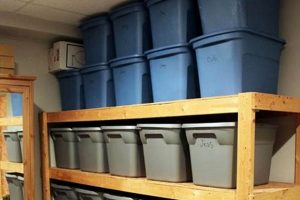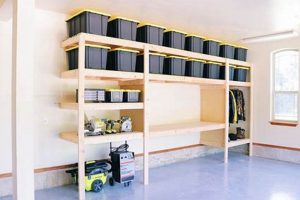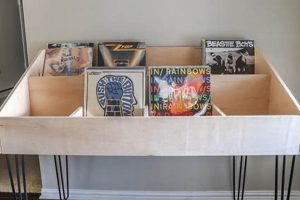Constructing storage solutions designed for placement beneath a bed, achieved through independent effort rather than purchasing pre-made units, characterizes a specific approach to space optimization. Such projects encompass a range of designs, from simple boxes on casters to more elaborate drawer systems built into custom frames. Examples include repurposed drawers from discarded furniture, fabricated wooden containers, and even fabric bins supported by a frame.
The advantages of maximizing unused space below a bed are considerable, particularly in smaller dwellings where square footage is limited. This method of organization can alleviate clutter, provide dedicated areas for seasonal items, and improve overall room functionality. Historically, individuals have adapted available resources for storage; however, the current emphasis on self-sufficiency and resourcefulness has fueled a renewed interest in these personally crafted solutions.
The subsequent sections will delve into the various materials suitable for creating these space-saving units, outline essential construction techniques, and offer design considerations for maximizing both accessibility and aesthetic appeal within the bedroom environment. Emphasis will be placed on practical approaches that balance cost-effectiveness with durable and visually harmonious results.
DIY Under Bed Storage
Optimizing space through independently crafted under-bed storage requires careful planning and execution. The following tips provide guidance for constructing functional and aesthetically pleasing units.
Tip 1: Material Selection is Paramount. Choose durable materials based on intended load and environment. Solid wood or plywood offers stability for heavier items. Consider moisture-resistant options for rooms prone to humidity.
Tip 2: Measure Accurately. Precise measurements of the available space under the bed are essential. Account for bed frame supports and floor obstructions. Erroneous measurements can result in unusable storage units.
Tip 3: Prioritize Accessibility. Design should facilitate easy access to stored items. Casters or wheels allow for effortless sliding. Handles or grips improve maneuverability, particularly with heavier containers.
Tip 4: Consider Weight Distribution. Evenly distribute weight within the units to prevent sagging or instability. Reinforce bottoms with additional supports if storing dense materials.
Tip 5: Incorporate Dust Protection. Under-bed locations are prone to dust accumulation. Employ lids or covers to protect stored items. Vacuuming regularly will help mitigate dust ingress.
Tip 6: Opt for Simple Construction. Complex designs increase the risk of structural weaknesses and construction errors. Begin with basic rectangular boxes or drawer systems before attempting more intricate forms.
Tip 7: Aesthetic Considerations Matter. While functionality is paramount, consider the visual integration of the storage units with the existing dcor. Paint, stain, or apply decorative finishes to complement the bedroom’s style.
Effective implementation of these tips will lead to functional, durable, and visually integrated storage solutions that maximize available space while maintaining organizational efficiency.
The subsequent section will address common challenges encountered during the construction process and offer solutions for overcoming these obstacles.
1. Dimensions
The spatial parameters, or dimensions, are a foundational determinant in the success and practicality of independently crafted under-bed storage. Precise measurement of the available volume beneath the bed frame directly dictates the size and configuration of the storage units that can be accommodated. An initial miscalculation in height, for instance, renders a completed storage container unusable if it cannot fit underneath the bed. Similarly, inaccurate length or width measurements result in wasted space or the inability to position multiple units effectively. The cause-and-effect relationship is clear: accurate dimensions are a prerequisite for functional storage.
Furthermore, the dimensions are not merely a static constraint, they also dictate the design approach. A low-profile space may necessitate shallow drawer systems or flat containers, while a larger vertical clearance allows for taller boxes or tiered storage. Consider a scenario where the under-bed height is limited to 6 inches. A deep storage container becomes impractical. Instead, flat bins for storing seasonal clothing or linens would be more appropriate. This adaptation demonstrates the practical significance of understanding and respecting the dimensional constraints.
In summary, accurate assessment and careful consideration of dimensions are indispensable for designing and constructing effective under-bed storage. The dimensional parameters define the boundaries within which functional and aesthetically pleasing solutions can be developed. Failure to accurately measure and adapt to these spatial limitations leads to inefficient storage and wasted resources. This understanding forms the bedrock of a successful project, ensuring that the final product meets the intended purpose and integrates seamlessly into the bedroom environment.
2. Materials
Material selection constitutes a critical decision point in the effective realization of independently constructed under-bed storage solutions. The properties inherent in various materials directly impact the structural integrity, durability, aesthetic appeal, and overall functionality of the resulting storage units. Careful consideration of material characteristics is therefore paramount.
- Wood and Wood Composites
Wood, including solid lumber, plywood, and particleboard, presents a range of options with varying strengths, weights, and costs. Solid wood offers superior structural integrity for heavy loads but can be more expensive and prone to warping if not properly seasoned. Plywood provides a balance of strength and affordability, making it a common choice for box construction. Particleboard is a lower-cost alternative but is less resistant to moisture and may sag under significant weight, limiting its suitability for storing heavier items. In practical terms, a frame constructed from solid pine and sheathed in plywood would be preferable to a particleboard-only construction for storing heavy books.
- Plastics
Plastic containers, either purchased or fabricated from sheet materials, offer moisture resistance and ease of cleaning. However, plastics generally lack the structural rigidity of wood and may deform under load, particularly in warmer environments. Furthermore, some plastics may off-gas volatile organic compounds (VOCs), which can affect air quality. An example would be using repurposed plastic storage tubs; these are ideal for storing seasonal clothes, as they protect from dust and moisture, but are less suitable for supporting heavier items like tools.
- Metal
Metal, such as steel or aluminum, provides exceptional strength and durability. Metal frameworks can be combined with other materials for panels or cladding. However, metal is often more expensive than wood or plastic and may require specialized tools and skills for fabrication. Furthermore, exposed metal edges can pose a safety hazard. The use of steel angle iron to construct a robust support frame for drawers, with wood or plastic drawer boxes inside, represents a practical application.
- Textiles
Fabric containers, often incorporating rigid internal supports, offer a lightweight and flexible storage solution. These are typically less expensive and easier to construct than rigid containers. However, textiles are susceptible to tearing, staining, and dust accumulation. Woven fabrics like canvas or heavy-duty nylon offer greater durability than lighter materials. For example, fabric bins with cardboard or plastic inserts are well-suited for storing clothing or linens, providing a cost-effective solution that prevents items from shifting and wrinkling.
These diverse material options present a range of trade-offs between cost, strength, durability, and aesthetic considerations. The optimal selection depends on the specific storage needs, the available budget, and the desired level of craftsmanship. By understanding the inherent properties of each material, individuals can make informed decisions that result in functional and long-lasting storage solutions that effectively utilize under-bed space.
3. Accessibility
The concept of accessibility constitutes a critical factor in the efficacy of do-it-yourself under-bed storage solutions. Ease of retrieval and replacement of stored items directly influences the usability and long-term value of such storage systems. Poor accessibility negates the benefits of space optimization, transforming a storage area into an impractical and frustrating repository. For example, a meticulously crafted storage box rendered inaccessible due to insufficient clearance or lack of a handle becomes functionally useless, regardless of its aesthetic appeal or construction quality. The cause-and-effect relationship between accessibility and usability is therefore paramount.
Practical considerations for enhancing accessibility include the incorporation of casters or wheels to facilitate effortless sliding of storage units from under the bed. The addition of handles or grip points allows for convenient maneuvering, particularly for heavier or bulkier items. Segmenting the storage space into smaller, modular units can improve accessibility by enabling selective retrieval of items without disturbing the entire contents. Imagine a scenario where seasonal clothing is stored in a single, large container. Accessing a specific item requires unpacking and repacking the entire container, a cumbersome and inefficient process. Conversely, dividing the clothing into smaller, labeled containers streamlines the retrieval process. The physical layout and design of a bedroom further influence accessibility. Units placed under the bed’s foot may offer greater access than those positioned along the sides, depending on room configuration and available space.
In summary, prioritizing accessibility transforms under-bed storage from a mere container into a functional and efficient organizational system. Incorporating design elements that facilitate easy retrieval and replacement of items enhances the usability and long-term value of the storage solution. Overlooking accessibility renders even the most well-constructed storage unit impractical and undermines its intended purpose. Addressing this aspect directly contributes to a more organized, efficient, and user-friendly living space.
4. Durability
Durability is a central determinant in the long-term effectiveness and value of independently constructed under-bed storage. The capacity of these units to withstand repeated use, weight loads, and environmental stressors directly impacts their lifespan and utility. Inadequate durability results in premature failure, necessitating repairs or replacements, thereby negating the cost and time savings associated with a do-it-yourself approach. For example, a storage box constructed from thin, unreinforced plywood will likely collapse under the weight of heavy books or seasonal clothing, rendering it unusable and requiring reconstruction. This cause-and-effect relationship underscores the practical significance of prioritizing durable materials and construction techniques.
The selection of appropriate materials and construction methods significantly influences the structural integrity and longevity of under-bed storage units. Choosing robust materials, such as solid wood or reinforced plywood, and employing secure fastening techniques, such as screws and adhesive, enhances the unit’s ability to withstand weight and stress. Furthermore, applying protective finishes, such as varnish or sealant, protects the materials from moisture and wear, extending their lifespan. Consider a scenario where two identical storage boxes are constructed, one with reinforced corners and a water-resistant finish, and the other without these features. The reinforced and finished box will withstand heavier loads and resist damage from spills, resulting in a longer lifespan and greater utility. This comparison exemplifies the practical application of durability considerations.
In conclusion, a focus on durability is essential for creating functional and cost-effective do-it-yourself under-bed storage solutions. Employing durable materials, robust construction techniques, and protective finishes ensures that these units withstand the rigors of regular use and maintain their structural integrity over time. Overlooking durability compromises the long-term value of the project and can lead to premature failure, necessitating costly repairs or replacements. Addressing this aspect contributes to a more sustainable and efficient use of resources, aligning with the core principles of self-sufficiency and resourcefulness inherent in the do-it-yourself ethos.
5. Aesthetics
The aesthetic integration of independently constructed under-bed storage units is a critical consideration, influencing the overall ambiance and visual harmony of a bedroom. While functionality remains paramount, neglecting aesthetic aspects can detract from the room’s intended design and create a sense of visual discord. The goal is to create storage solutions that seamlessly blend with the existing decor, enhancing rather than disrupting the overall aesthetic.
- Material and Finish Harmony
The selection of materials and finishes should complement the existing furniture and architectural elements within the room. Matching wood tones, paint colors, or hardware styles creates a cohesive visual experience. For example, if the bedroom features dark wood furniture, employing a similar stain on the storage units promotes visual consistency. Conversely, introducing contrasting materials or colors without careful consideration can create a jarring effect.
- Visibility and Concealment
The degree to which the storage units are visible influences their aesthetic impact. Concealed storage, achieved through flush-fitting doors or panels that match the bed frame, minimizes visual intrusion. Visible storage, on the other hand, can be incorporated as a design element through the use of decorative containers or exposed shelving. The choice between visibility and concealment depends on the desired aesthetic and the overall style of the room. A minimalist aesthetic might favor concealed storage, while a more eclectic style could incorporate visible storage as a design feature.
- Form and Proportion
The shape and size of the storage units should be proportional to the dimensions of the bed and the overall scale of the room. Overly large or bulky units can visually overwhelm the space, while undersized units may appear insignificant and lack functionality. A balanced approach, taking into account the room’s proportions and the intended storage capacity, is crucial. For instance, in a small bedroom, low-profile storage units that extend the full width of the bed frame can create a sense of visual continuity and maximize storage space without overwhelming the room.
- Hardware and Detailing
The selection of hardware, such as handles, knobs, and casters, can significantly impact the aesthetic appeal of the storage units. Simple, understated hardware contributes to a clean and modern look, while more ornate or decorative hardware can enhance a traditional or vintage style. Paying attention to these details elevates the overall design and demonstrates a commitment to aesthetic coherence. The use of brushed nickel hardware on storage units designed to complement a bedroom with similar metal accents exemplifies this principle.
These aesthetic considerations, when thoughtfully integrated into the design and construction process, transform independently crafted under-bed storage from a purely functional element into a visually harmonious component of the bedroom. By carefully selecting materials, finishes, forms, and details, individuals can create storage solutions that not only maximize space but also enhance the overall aesthetic appeal and create a more comfortable and inviting living environment.
Frequently Asked Questions
The following addresses common inquiries pertaining to the design, construction, and implementation of independently crafted under-bed storage solutions. These responses aim to clarify potential challenges and provide practical guidance.
Question 1: What is the optimal height for under-bed storage units to maximize space without hindering accessibility?
The ideal height is contingent upon the clearance beneath the bed frame. Accurate measurement is essential. Subtract at least one inch from the total available height to allow for ease of movement and prevent scraping. Low-profile units may be necessary for beds with minimal clearance.
Question 2: What materials are best suited for constructing durable and cost-effective under-bed storage containers?
Plywood provides a balance of strength, affordability, and ease of workability. Solid wood offers superior durability but can be more expensive. Particleboard is a cost-effective alternative but is less resistant to moisture and may sag under heavy loads.
Question 3: How can under-bed storage units be effectively protected from dust accumulation?
Employing lids or covers provides a physical barrier against dust. Vacuuming the area beneath the bed regularly reduces dust accumulation. Sealing the seams and edges of the storage units can further minimize dust ingress.
Question 4: What are the key considerations for ensuring that under-bed storage units are easy to move and maneuver?
The incorporation of casters or wheels allows for smooth sliding. Handles or grips provide secure points for lifting and pulling. Ensure that the casters are appropriately sized for the weight of the loaded storage units.
Question 5: How can the aesthetic integration of under-bed storage units be achieved to complement the existing bedroom decor?
Matching the materials and finishes of the storage units to the existing furniture creates visual harmony. Selecting hardware styles that complement the room’s design enhances the overall aesthetic. Concealing the storage units with flush-fitting doors or panels minimizes visual intrusion.
Question 6: What are the most common challenges encountered during the construction of under-bed storage and how can they be addressed?
Inaccurate measurements can result in unusable storage units. Poor material selection can compromise structural integrity. Insufficient fastening can lead to joint failure. Thorough planning, precise measurements, and the use of appropriate materials and techniques are crucial for avoiding these challenges.
These questions and answers provide a foundation for addressing common concerns related to the creation of do-it-yourself under-bed storage solutions. Further research and careful planning are recommended for optimal results.
The subsequent section will explore advanced design considerations for maximizing the functionality and aesthetic appeal of these storage solutions.
Conclusion
This exploration of diy under bed storage has addressed key considerations for effective implementation. Emphasis has been placed on accurate measurement, material selection based on durability and cost-effectiveness, accessibility enhancements, dust protection strategies, and aesthetic integration. Addressing these factors directly influences the functionality and longevity of these storage solutions.
The successful creation of such projects requires meticulous planning and execution. Resourcefulness and attention to detail are paramount. The optimization of unused space represents a practical solution for maximizing organizational efficiency within limited living environments. Continued refinement of these techniques promises to enhance the utility and aesthetic appeal of personalized storage solutions.







